-

Motín en la fragata Numancia
El motín en la fragata Numancia se produjo la noche del 1 al 2 de agosto de 1911 cuando un fogonero, Antonio Sánchez Moya, un artillero y otros doce miembros de la tripulación de la fragata Numancia se amotinaron cuando realizaban labores como acorazado guardacosta en aguas de Tánger.
-

1911 Liverpool general transport strike
The 1911 Liverpool general transport strike, also known as the great transport workers' strike, involved dockers, railway workers and sailors, as well people from other trades. It paralysed Liverpool commerce for most of the summer of 1911. It also transformed trade unionism on Merseyside. For the first time, general trade unions were able to establish themselves on a permanent footing and become genuine mass organisations of the working class.
-

Railway Protection Movement
The Railway Protection Movement (simplified Chinese: 保路运动; traditional Chinese: 保路運動 Baolu yundong), also known as the "Railway Rights Protection Movement", was a political protest movement that erupted in 1911 in late Qing China against the Qing government's plan to nationalize local railway development projects and transfer control to foreign banks. The movement, centered in Sichuan province, expressed mass discontent with Qing rule, galvanized anti-Qing groups and contributed to the outbreak of the Xinhai Revolution. The mobilization of imperial troops from neighboring Hubei Province to suppress the Railway Protection Movement created the opportunity for revolutionaries in Wuhan to launch the Wuchang Uprising, which triggered the revolution that overthrew the Qing dynasty and established the Republic of China.
-

Illinois Central shopmen's strike of 1911
The Illinois Central shopmen's strike of 1911 was a labor action in the United States of a number of railroad workers unions against the Illinois Central Railroad, beginning on September 30, 1911. The strike was marked by its violence in numerous locations. At least 12 men were killed in shootings across the country, and in March 1912, some 30 men were killed when a locomotive boiler exploded in San Antonio, Texas.
-

Jellaz Affair
The Jellaz Affair (Arabic: أحداث ٱلجلّاز Aḥdāth ul-Jallāz) (French: Affaire du Djellaz) was a violent confrontation in November 1911 between Tunisian protesters and the authorities of the French Protectorate of Tunisia which began at the Jellaz Cemetery. Over the course of two days, it became a series of fights and attacks in the streets, primarily involving Tunisians and Italian settlers. It was the most serious outbreak of violence in Tunis, and the first time French soldiers fired on the civilian population, since the establishment of the Protectorate in 1881. It was therefore a critical juncture in the development of the Tunisian nationalist movement.
-

Llanelli riots of 1911
The Llanelli riots of 1911 were a series of events precipitated by the National Railway Strike of 1911. Mass picketing action at Llanelli railway station was brutally suppressed by the police, resulting in the deaths of two men, shot dead by troops of the Worcestershire Regiment. Rioting followed and magistrates' homes were attacked and railway trucks were set on fire, resulting in an explosion which killed a further four people.
-

National Railway strike of 1911
National Railway strike of 1911 was the first national strike of railway workers in Britain. It arose from longstanding disputes between workers and railway companies, combined with the desire of the unions to assert their unity and strength. The strike lasted only two days, but the show of strength succeeded in forcing the Liberal Government to set up a Royal Commission to examine the workings of the 1907 Conciliation Board. The strike also led to the Llanelli Riots of 1911, in which six people died in clashes between railway workers and troops, which had been sent in to stop the blockade of the line by strikers.
-

Seattle Fishermen halibut strike of 1912
The Seattle Fishermen's halibut strike of 1912 took place the year after a decision to establish the Port of Seattle and before construction had begun. The strike, organised by the newly formed Deep Sea Fishermen's Union, lasted three months. The issues causing the strike were working conditions, wages, and regulation of catches and prices, and by the terms on which it was settled the strikers achieved some of their aims.
-
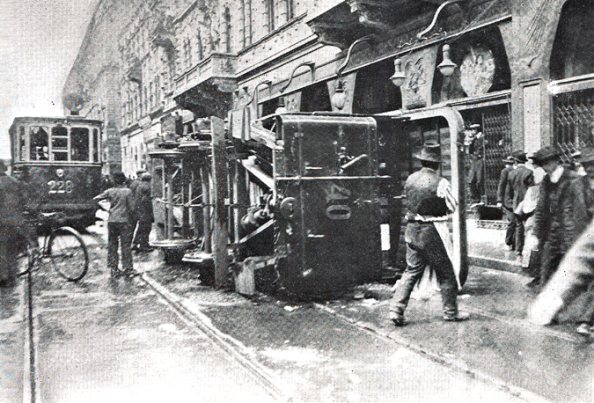
Vérvörös csütörtök
A Vérvörös csütörtök egy budapesti tömegtüntetés volt 1912. május 23-án, amelyet a kivezényelt rendőrök és katonák brutálisan feloszlattak. A kivezényelt erőkkel való összecsapásoknak több áldozata és számos sebesültje is volt, innen kapta a megmozdulás a Vérvörös csütörtök elnevezést.
-

Paint Creek Cabin Creek strike of 1912
The Paint Creek–Cabin Creek Strike, or the Paint Creek Mine War, was a confrontation between striking coal miners and coal operators in Kanawha County, West Virginia, centered on the area enclosed by two streams, Paint Creek and Cabin Creek.
-

1912 Fez riots
The Fes Riots, also known as the Fes Uprising or Mutiny (from Arabic: انتفاضة فاس, Intifadat Fes), the Tritl (Hebrew: התריתל, among the Jewish community) and the Bloody Days of Fes (from French: Les Journées Sanglantes de Fès) were riots which started April 17, 1912 in Fes, then the capital of Morocco, when French officers announced the measures of the Treaty of Fes, which created the French protectorate in Morocco.
-
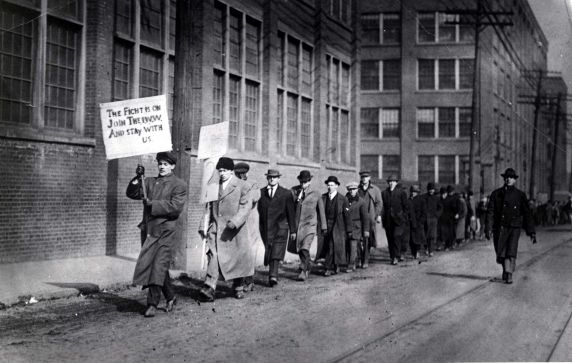
1912 Lawrence textile strike
The Lawrence Textile Strike, also known as the Bread and Roses Strike, was a strike of immigrant workers in Lawrence, Massachusetts, in 1912 led by the Industrial Workers of the World (IWW). Prompted by a two-hour pay cut corresponding to a new law shortening the workweek for women, the strike spread rapidly through the town, growing to more than twenty thousand workers and involving nearly every mill in Lawrence. On January 1, 1912, the Massachusetts government enforced a law that cut mill workers' hours in a single work week from 56 hours, to 54 hours. Ten days later, they found out that pay had been reduced along with the cut in hours.
-

Waihi miners' strike
The Waihi miners' strike was a major strike action in 1912 by gold miners in the New Zealand town of Waihi. It is widely regarded as the most significant industrial action in the history of New Zealand's labour movement. It resulted in one striker being killed, one of only two deaths in industrial actions in New Zealand.
-

1912 New York City waiters' strike
The 1912 New York City waiters’ strike began on May 7, 1912 at the Belmont Hotel and was the first general strike for waiters and hotel workers in New York City history. That day over 150 hotel workers walked out as a sign of protest against their poor working conditions. The strike was organized by Joseph James Ettor and Elizabeth Gurley Flynn of the Industrial Workers of the World (IWW) in conjunction with the Hotel Workers' International Union. At the height of the strike there were 54 hotels and 30 restaurants and other establishments without their staff. This amounted to 2,500 waiters, 1,000 cooks, and 3,000 other striking hotel workers. The strike continued through the rest of May but police began reprimanding protestors, making many of them go back to work. The strike officially ended on June 25, 1912.
-

1912 Brisbane general strike
The 1912 Brisbane General Strike in Queensland, Australia, began when members of the Australian Tramway and Motor Omnibus Employees' Association were dismissed when they wore union badges to work on 18 January 1912. They then marched to Brisbane Trades Hall where a meeting was held, with a mass protest meeting of 10,000 people held that night in Market Square (also known as Albert Square, now King George Square).
-

Lena massacre
The Lena Massacre or Lena Execution (Russian: Ленский расстрел, Lenskiy rasstrel) refers to the shooting of goldfield workers on strike in northeast Siberia near the Lena River on 17 April [O.S. 4 April] 1912.
-

Bergarbeiterstreik von 1912
Der Bergarbeiterstreik von 1912 auch Dreibundstreik genannt war der dritte große Ausstand von Bergarbeitern im Ruhrbergbau.
-
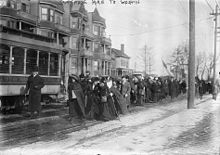
Suffrage Hikes
The Suffrage Hikes of 1912 to 1914 brought attention to the issue of women's suffrage. Florence Gertrude de Fonblanque organised the first from Edinburgh to London. Within months Rosalie Gardiner Jones had organized the first American one which left from The Bronx to Albany, New York. The second hike was from New York City to Washington, D.C., and covered 230 miles in 17 days.
-

National coal strike of 1912
The national coal strike of 1912 was the first national strike by coal miners in the United Kingdom. Its main goal was securing a minimum wage. After 37 days, the government intervened and ended the strike by passing the Coal Mines Act, establishing a minimum wage for the first time.
-

Indianapolis streetcar strike of 1913
The Indianapolis streetcar strike of 1913 and the subsequent police mutiny and riots was a breakdown in public order in Indianapolis, Indiana. The events began as a workers strike by the union employees of the Indianapolis Traction & Terminal Company and their allies on Halloween night, October 31, 1913. The company was responsible for public transportation in Indianapolis, the capital city and transportation hub of the U.S. state of Indiana. The unionization effort was being organized by the Amalgamated Street Railway Employees of America who had successfully enforced strikes in other major United States cities. Company management suppressed the initial attempt by some of its employees to unionize and rejected an offer of mediation by the United States Department of Labor, which led to a rapid rise in tensions, and ultimately the strike. Government response to the strike was politically charged, as the strike began during the week leading up to public elections. The strike effectively shut down mass transit in the city and caused severe interruptions of statewide rail transportation and the 1913 city elections.
-

Copper Country strike of 1913 14
Select mining companies of the Copper Country:
-

Dublin lock out
The Dublin lock-out was a major industrial dispute between approximately 20,000 workers and 300 employers which took place in Ireland's capital city of Dublin. The dispute lasted from 26 August 1913 to 18 January 1914, and is often viewed as the most severe and significant industrial dispute in Irish history. Central to the dispute was the workers' right to unionise.
-
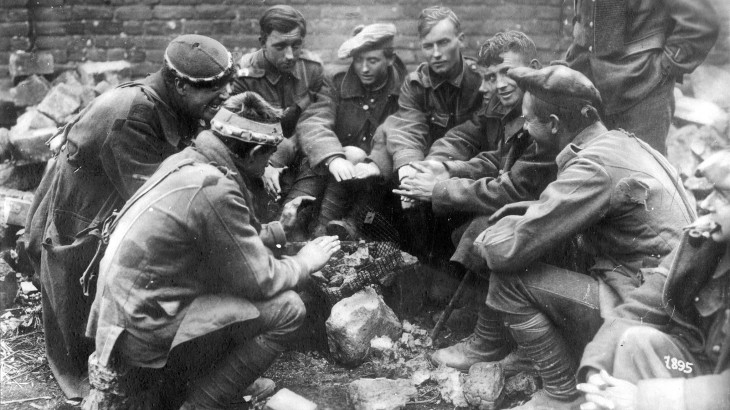
1913 Great Strike
The Great Strike refers to a near general strike that took place in New Zealand from October 1913 to mid-January 1914. It was the largest and most disruptive strike in New Zealand's history. At its height, it brought the economy of New Zealand almost to a halt. Between 14,000 and 16,000 workers went on strike, out of a population of just over one million.
-
1913 Sligo Dock strike
The 1913 Sligo Dock strike in Sligo port in northwest Ireland was a labour dispute lasting 56 days from March 8th to May 6th of 1913. During the strike there were numerous clashes on the docks and riots in the town, resulting in one fatality.Occurring six months earlier than the Dublin Lockout it was regarded as a precursor to that action and a successful application of the Irish Transport & General Workers Union’s strategy for workers rights by James Larkin and James Connolly.It resulted in victory for the workers. James Larkin considered the 1913 victory in Sligo to be a major achievement of the ITGWU.
-

Leith dockers strike 1913
The Leith dockers strike of 1913 was a strike of the dockers of Leith, Edinburgh, Scotland, from 26 June to 14 August 1913. The Dockers were part of the National Union of Dock Labourers (NUDL) union. The strike is said to have brought Leith to a standstill.
-
Belgian general strike of 1913
The general strike of 1913 (French: grève générale de 1913, Dutch: algemene staking van 1913) was a major general strike in Belgium. It was the third general strike aimed at forcing electoral reform and, like the general strike of 1902, was particularly aimed at ending the system of plural voting. It officially lasted between 14 and 24 April and brought out between 300,000 and 450,000 workers on strike. Despite its large participation, it was relatively peaceful.
-

1913 Paterson silk strike
The 1913 Paterson silk strike was a work stoppage involving silk mill workers in Paterson, New Jersey. The strike involved demands for establishment of an eight-hour day and improved working conditions. The strike began in February, 1913, and ended five months later, on July 28th. During the course of the strike, approximately 1,850 strikers were arrested, including Industrial Workers of the World (IWW) leaders William Dudley Haywood and Elizabeth Gurley Flynn.
-

Arbetartåget
Arbetartåget var ett demonstrationståg som anordnades av socialdemokratiska Stockholms arbetarekommun med ungefär 50 000 deltagare den 8 februari 1914 i Stockholm. Manifestation var ett svar på de kungavänliga konservativas kampanj för mer pengar till armén. Höjdpunkten i denna högerns kampanj var bondetåget som ägde rum två dagar tidigare.
-

Butte, Montana labor riots of 1914
The Butte, Montana labor riots of 1914 were a series of violent clashes between copper miners at Butte, Montana. The opposing factions were the miners dissatisfied with the Western Federation of Miners local at Butte, on the one hand, and those loyal to the union local on the other. The dissident miners formed a new union, and demanded that all miners must join the new union, or be subject to beatings or forced expulsion from the area. Sources disagree whether the dissidents were a majority of the miners, or a militant minority. The leadership of the new union contained many who were members of the Industrial Workers of the World (I.W.W.), or agreed with the I.W.W.'s methods and objectives. The result of the dispute between rival unions was that the copper mines of Butte, which had long been a union stronghold for the WFM, became open shop employers, and recognized no union from 1914 until 1934.
-

1914 Saint John street railway strike
The Saint John street railway strike of 1914 (sometimes called the Saint John street railwaymen's strike) was a strike by workers on the street railway system in Saint John, New Brunswick, Canada, which lasted from 22–24 July 1914, with rioting by Saint John inhabitants occurring on 23 and 24 July. The strike was important for shattering the image of Saint John as a conservative town dominated primarily by ethnic and religious (rather than class) divisions, and highlighting tensions between railway industrialists and the local working population.
-

Ghadar Mutiny
The Ghadar Mutiny (Hindustani: ग़दर राज्य-क्रान्ति, غدر ریاست - کرانتی Ġadara Rājya- krānti), also known as the Ghadar Conspiracy, was a plan to initiate a pan-Indian mutiny in the British Indian Army in February 1915 to end the British Raj in India. The plot originated at the onset of World War I, between the Ghadar Party in the United States, the Berlin Committee in Germany, the Indian revolutionary underground in British India and the German Foreign Office through the consulate in San Francisco. The incident derives its name from the North American Ghadar Party, whose members of the Punjabi Sikh community in Canada and the United States were among the most prominent participants in the plan. It was the most prominent amongst a number of plans of the much larger Hindu–German Mutiny, formulated between 1914 and 1917 to initiate a Pan-Indian rebellion against the British Raj during World War I. The mutiny was planned to start in the key state of Punjab, followed by mutinies in Bengal and rest of India. Indian units as far as Singapore were planned to participate in the rebellion. The plans were thwarted through a coordinated intelligence and police response. British intelligence infiltrated the Ghadarite movement in Canada and in India, and last-minute intelligence from a spy helping to crush the planned uprising in Punjab before it started. Key figures were arrested, mutinies in smaller units and garrisons within India were also crushed.
-
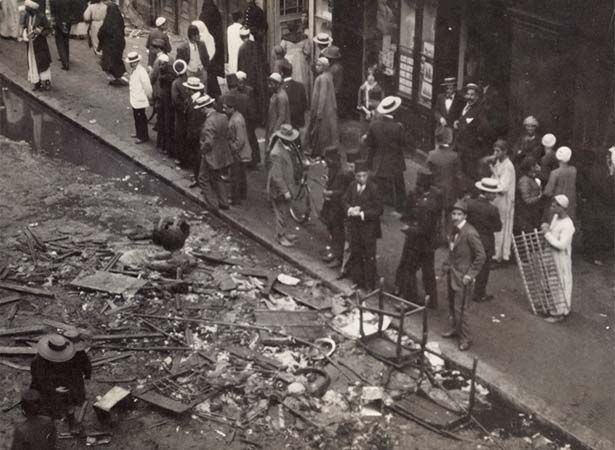
Battle of the Wazzir
The Battle of the Wazzir was the name given to a riot that took place in Cairo, Egypt, on 2 April 1915 during World War I. The riot took hold in a street called "Haret el Wasser", part of the Wagh El Birket area of Cairo where there were a large number of brothels and drinking establishments. At its peak about 2,500 Australian and New Zealand soldiers were involved, many of whom were intoxicated. The soldiers were reported to have had an assortment of complaints, including recent price increases, poor quality drinks, and concerns about the spread of venereal disease. The riot resulted in considerable damage – estimated at several hundred pounds worth – to several brothels which were set on fire; firefighters who responded to the blaze were also accosted. In response, mounted police were dispatched, as well as yeomanry, Lancashire Territorials and military police.
-

Bayonne refinery strikes of 1915 16
The Bayonne refinery strikes of 1915–1916 were labor actions of refinery workers in Bayonne, New Jersey, mostly Polish-Americans who struck Standard Oil of New Jersey and Tidewater Petroleum plants on Constable Hook beginning in mid-July 1915.
-

1915 Sinhalese Muslim riots
The 1915 Sinhalese-Muslim riots (also known as the anti-Muslim riots of or the 1915 Buddhist Mohammedan riots or the 1915 Ceylonese riots) was a widespread and prolonged ethnic riot in the island of Ceylon between Sinhalese Buddhists and the Ceylon Moors and the brutal suppression of it by the British colonial authorities.
-

Battle of the Hatpins
The Battle of the Hatpins (French: Bataille des épingles à chapeaux) was a 1916 protest that occurred in Ottawa, Ontario, Canada, over the effects of provincial Regulation 17. First passed in 1912 and more strictly enforced beginning in 1915–1916, the regulation restricted French- language education in the province of Ontario. Over 70 women used common household objects such as hatpins and frying pans to fight off 30 police officers intent on arresting two sisters, Béatrice and Diane Desloges, for teaching in French in an Ottawa school. The battle was part of a cultural resistance movement that led to bilingual education being officially reinstated in 1927. Regulation 17 was apologized for by the Ontario government over 100 years later.
-

Liverpool riot of 1916
The Liverpool Riot of 1916 also known as the Battle of Central Station was an event in Sydney, Australia where a large group of Australian soldiers rioted through the streets of Sydney and surrounding areas.
-

1916 Portland, Maine streetcar strike
The Portland, Maine Streetcar Strike occurred from July 12 to July 17, 1916 in Portland, Maine, United States. It was won by the workers largely due to overwhelming public support.
-

Demonstratie voor Vrouwenkiesrecht 18 juni 1916
Op 18 juni 1916 gingen achttienduizend vrouwen en mannen de Amsterdamse straten op om te demonstreren voor het vrouwenkiesrecht. De demonstratie was een initiatief van de Vereeniging voor Vrouwenkiesrecht. Verschillende partijen waren betrokken bij de organisatie. De demonstratie vormde de opmaat tot het invoeren van algemeen kiesrecht voor vrouwen in de grondwet. Het bestuur van de Vereeniging voor Vrouwenkiesrecht nodigde verschillende organisaties uit voor het evenement. Hiermee wilden de vrouwen aantonen dat algemeen kiesrecht voor vrouwen in alle lagen en groepen van de Nederlandse samenleving breed gedragen en belangrijk geacht werd.
-

1917 Potato riots
The Potato riots in June–July 1917 was a popular uprising in the Dutch capital city Amsterdam that was caused by the food shortage in the Netherlands during World War I.
-

1917 Chester race riot
The 1917 Chester race riot was a race riot in Chester, Pennsylvania that took place over four days in July 1917. Racial tensions in Chester increased greatly during the World War I industrial boom due to white hostility toward the large influx of southern blacks who moved North as part of the Great Migration.
-

1917 Bath riots
The 1917 Bath Riots occurred from January 28 to 30, 1917 at the Santa Fe Bridge between El Paso, Texas and Juárez, Mexico. The riots were sparked by the dehumanizing and deadly practices of the Immigration and Naturalization Service, which required Mexicans to "strip naked and be disinfected with various chemical agents, including gasoline, kerosene, sodium cyanide, cyanogens, sulfuric acid, and Zyklon B before gaining entry into the United States." Zyklon B, the fumigation of choice on the U.S.-Mexico border, was later used in the gas chambers of Nazi Germany. Police officers were also accused of taking and sharing nude photography of Mexican women bathers. A year earlier, 50 Mexicans had their bodies sprayed with gasoline and set on fire, causing 27 of them to burn to death. All of these conditions contributed to the riots, which began when Carmelita Torres refused to submit to the procedure. Torres was denied a refund of her transport fare, so she began yelling at the officials and convinced other riders to join her. After three days of rioting, the protest subsided, but the process of disinfecting Mexican migrants at the U.S. border continued for another 40 years.
-
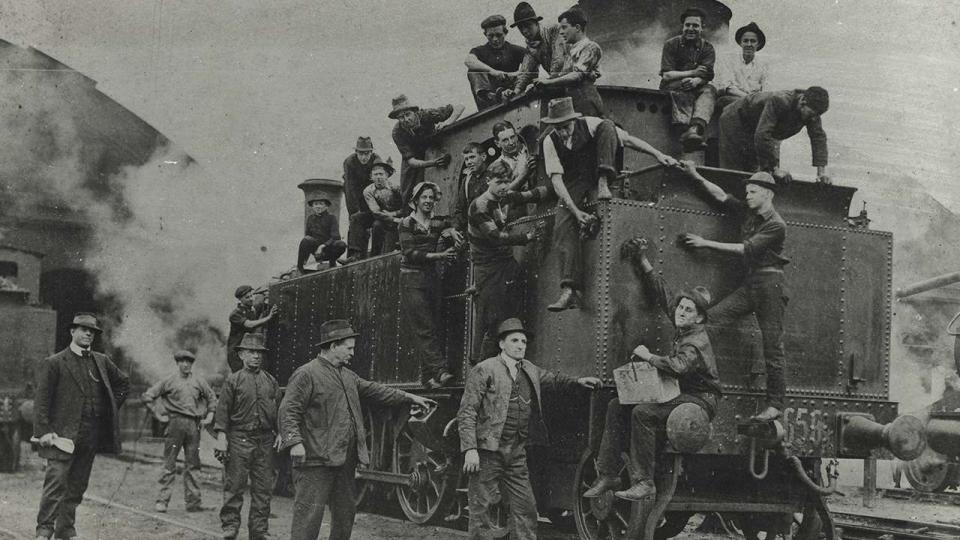
1917 Australian general strike
Usually referred to as the "New South Wales General Strike", but referred to by contemporaries as "the Great Strike", it was in fact neither general nor confined to NSW. The strike was however a mass strike, involving around 100,000 workers, mostly in NSW and Victoria. It began in the Australian state of New South Wales and spread to other states over six weeks from 2 August to 8 September 1917 when the official leadership declared the strike over. It took two weeks for all the railway strikers to return, however, as rank and file meetings initially rejected the official capitulation. Outside the railways, significant groups such as the waterside workers in Sydney and Melbourne, and the Hunter Valley coal mines remained out until November (or December in the case of the Melbourne waterfront) as in their case the use of strikebreakers had turned the strike into a lockout.
-

Silent Parade
The Negro Silent Protest Parade, commonly known as the Silent Parade, was a silent march of about 10,000 African Americans along Fifth Avenue starting at 57th Street in New York City on July 28, 1917. The event was organized by the NAACP, church, and community leaders to protest violence directed towards African Americans, such as recent lynchings in Waco and Memphis. The parade was precipitated by the East St. Louis riots in May and July 1917 where at least 40 black people were killed by white mobs, in part touched off by a labor dispute where blacks were used for strike breaking.
-

Helsingin kirkkomellakat 1917
Helsingin kirkkomellakoilla viitataan Venäjän vallankumouksen aikana touko-kesäkuussa 1917 Helsingin kirkoissa esiintyneisiin levottomuuksiin. Niiden aiheuttajina olivat kirjailija Arvid Järnefelt sekä asianajaja ja toimittaja Jean Boldt, jotka pitivät kirkoissa omia, ajoittain jopa mellakoinniksi muuttuneita puhetilaisuuksiaan. Levottomuudet huipentuivat kesäkuussa Boldtin johtamien anarkistien tekemään Nikolainkirkon eli nykyisen Helsingin tuomiokirkon valtaukseen.
-

Eestlaste demonstratsioon Petrogradis Vikipeedia
Eestlaste demonstratsioon Petrogradis oli 1917. aasta vkj 26. märtsil/ukj 8. aprillil Petrogradis korraldatud meeleavaldus, millega sooviti mõjutada Venemaa Ajutist Valitsust kinnitama seaduseelnõu Liivimaa kubermangu eestlastega asustatud põhjaalade liitmiseks Eestimaa kubermanguga ning ühtse autonoomse Eestimaa kubermangu moodustamist. Ametlikult korraldati rongkäik Eesti talurahva vabastamise mälestuseks.
-
East St. Louis riots
The East St. Louis Massacre was a series of outbreaks of labor- and race-related violence by white people who murdered between 40 and 250 African-Americans in late May and early July 1917. Another 6,000 blacks were left homeless and the burning and vandalism cost approximately $400,000 ($7,982,000 in 2020) in property damage. The events took place in and near East St. Louis, Illinois, an industrial city on the east bank of the Mississippi River, directly opposite the city of St. Louis, Missouri. The July 1917 episode in particular was marked by white-led violence throughout the city. The multi-day massacre has been described as the "worst case of labor-related violence in 20th-century American history", and among the worst racial massacres in U.S. history.
-

New York City Food Riot of 1917
The New York City Food Riot of 1917 were a series of demonstrations and riots which began on February 19, 1917, after a mob composed mostly of women confronted store and pushcart owners over the raising of prices following the shortages of World War I.
-
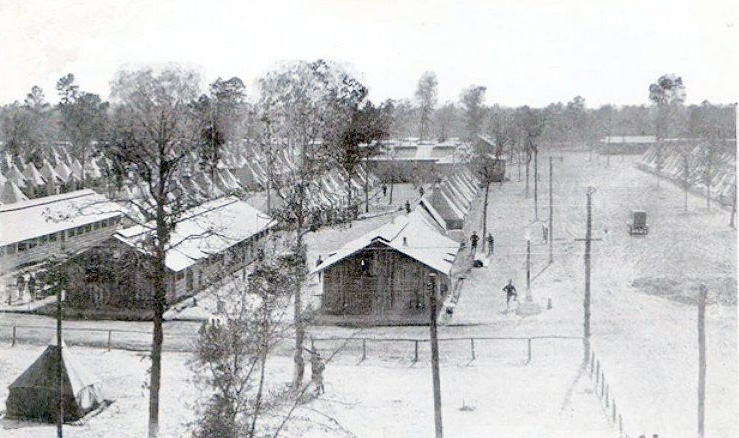
Houston riot of 1917
The Camp Logan Mutiny (also called the Houston Riot of 1917) occurred on 23 August 1917. It was a mutiny and riot by 156 soldiers of the Third Battalion of the all-black Twenty-fourth United States Infantry Regiment. The riot occurred after members of the Houston Police Department harassed members of the local black community and the black soldiers who attempted to intervene were also violently accosted. The black soldiers mutinied and marched on Houston, shooting and killing numerous people. It took place over a single night, and resulted in the deaths of 11 civilians and five policemen. Four soldiers were also killed from friendly fire and Sergeant Vida Henry, who led the mutineers, committed suicide. The soldiers were tried at three courts-martial for mutiny. Nineteen were executed, and 41 were sentenced to life imprisonment.
-

Vuoden 1917 yleislakko
Vuoden 1917 yleislakko oli Suomessa 14.–20. marraskuuta 1917 toteutettu yleislakko.
-

1917 1919 Brazil strike movement
From 1917 to 1919, a large strike movement shook Brazil. It culminated in several general strikes in 1917 and an attempted anarchist uprising in November 1918.
-
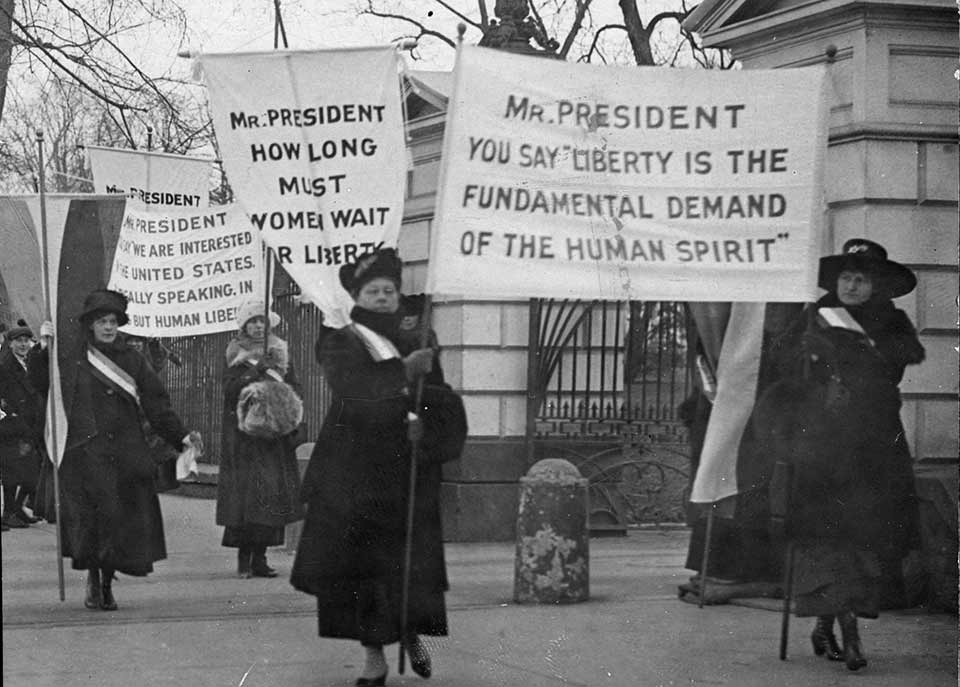
Silent Sentinels
The Silent Sentinels were a group of women in favor of women's suffrage organized by Alice Paul and the National Woman's Party. They protested in front of the White House during Woodrow Wilson's presidency starting on January 10, 1917. The Silent Sentinels started to protest after a meeting with the president on January 9, 1917, during which he told the women to "concert public opinion on behalf of women's suffrage." The protesters served as a constant reminder to Wilson of his lack of support for suffrage. At first the picketers were tolerated, but they were later arrested on charges of obstructing traffic. The women protested at the White House gates and later in Lafayette Square until June 4, 1919 when the Nineteenth Amendment to the United States Constitution was passed both by the House of Representatives and the Senate.
-

Grève générale de 1917 en Espagne
Vous pouvez partager vos connaissances en l’améliorant (comment ?) selon les recommandations des projets correspondants.
-
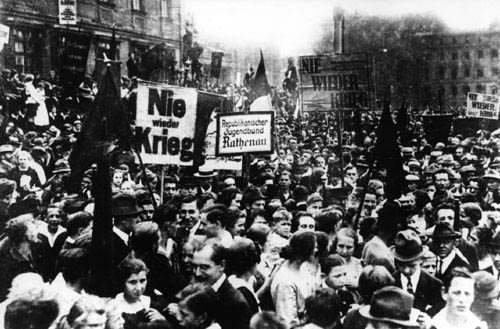
German strike of January 1918
German strike of January 1918 was a strike against the First World War which spread across Germany. It lasted from 25 January to 1 February 1918. It is known as the "Januarstreik", as distinct from the "Jännerstreik" which preceded it spreading across the Austro-Hungarian Empire between January 3 and 25, 1918. The strike began in Berlin on 28 January and spread across the rest of Germany, but finally collapsed.
-

1918 Swiss general strike
The 1918 Swiss general strike (German: Landesstreik) took place from November 12 to 14 and involved around 250,000 workers.
-

Belatinci pogrom
A belatinci pogrom 1918 novemberében a Vendvidék déli részén levő Belatinc (ma Beltinci, Szlovénia) helységben történt, részint az újonnan létrejött Szerb–Horvát–Szlovén Királyságból jövő agitáció miatt, amely a zsidókat vádolja heves propaganda kifejtésével, amit azért tesznek, hogy a magyarországi szlovének (vendek) lakta területeket ne csatolják a délszláv államhoz.Tulajdonképpen zsidóellenességgel leplezték köztörvényes egyének, hogy a mezővárosban élő módos polgárok (akik között kevés zsidó volt!) vagyonára rátehessék a kezüket és randalírozhassanak.
-
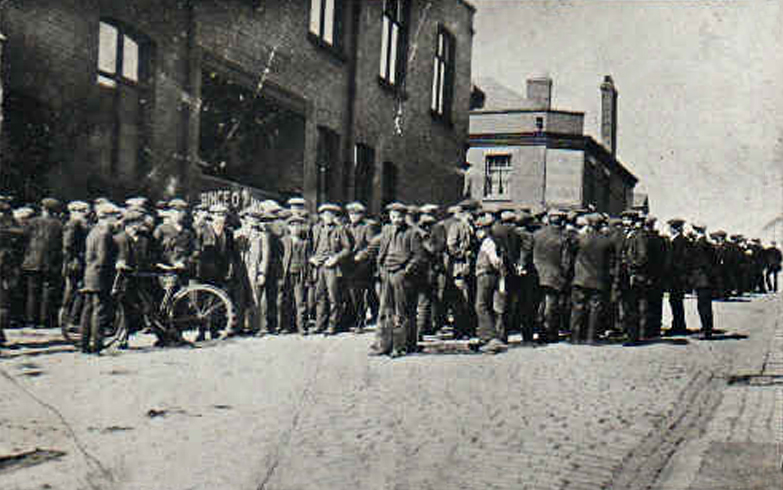
British police strikes in 1918 and 1919
The police strikes of 1918 and 1919 in the United Kingdom resulted in the British government putting before Parliament its proposals for a Police Act, which established the Police Federation of England and Wales as the representative body for the police. The Act barred police from belonging to a trade union or affiliating with any other trade union body. This Act, drafted and passed into law, was passed in response to the formation of the National Union of Police and Prison Officers (NUPPO). A successful police strike in 1918 and another strike in June 1919 led to the suppression of the union by the government. On 1 August 1919, the Police Act of 1919 passed into law. Only token opposition from a minority of Labour Members of Parliament was voiced in Parliament.:26
-
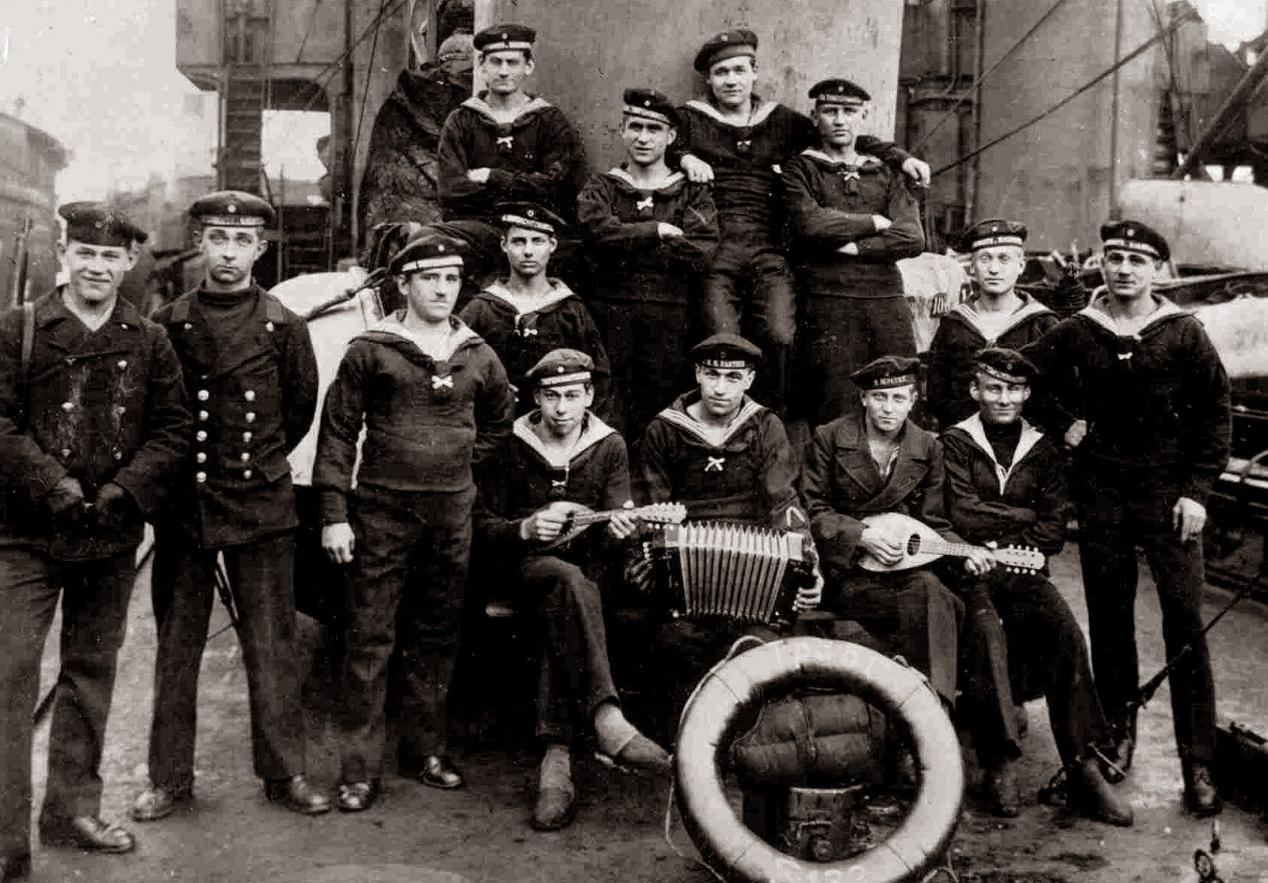
Kiel mutiny
The Kiel mutiny (German: Kieler Matrosenaufstand) was a major revolt by sailors of the German High Seas Fleet on 3 November 1918. The revolt triggered the German revolution which was to sweep aside the monarchy within a few days. It ultimately led to the end of the German Empire and to the establishment of the Weimar Republic.
-

Rumburk rebellion
The Rumburk rebellion was a mutiny by Czech soldiers in the Austro-Hungarian Army during the First World War. It took place on 21 May 1918 in the town of Rumburk in North Bohemia.
-

Lwów pogrom (1918)
The Lwów pogrom (Polish: pogrom lwowski, German: Lemberger Pogrom) was a pogrom perpetrated by Polish soldiers and civilians against Jewish population of the city of Lwów (since 1945, Lviv, Ukraine) on 21–23 November 1918, during the Polish–Ukrainian War that followed World War I.
-

Austro Hungarian strike of January 1918
The 1918 Austro-Hungarian January Strike was a strike which spread across the Austro-Hungarian empire between January 3 and 25, 1918 demanding better living and working conditions and an end to the First World War. It is known as the "Jännerstreik" as opposed to the "Januarstreik" – a similar strike movement which lasted from 25 January to 1 February 1918 in Germany - Jänner being the usual spelling for January in Austria.
-

1918 Vancouver general strike
The 1918 Vancouver General Strike was the first general strike in Canadian history and took place on 2 August 1918. There had been talks of organizing a general strike for quite some time due to federal conscription, censorship of socialist publications, and workers demands for higher wages. War-time inflation reduced real income profoundly and throughout the First World War Vancouver shipbuilders experienced a labor shortage. Numerous government policies had suppressed the work of labour activists such as strikes, lockouts and certain presses being banned. Workers were also inspired by factors such as the Bolshevik Revolution the previous year and the rising cost of living. The strike was eventually organized as a one-day political protest after the killing of draft evader and labour activist Albert "Ginger" Goodwin on July 27th. He had previously called for a general strike in the event that any worker was drafted against their will.
-

1918 Toronto anti Greek riot
The 1918 Toronto anti-Greek riot was a three-day race riot in Toronto, Ontario, Canada, targeting Greek immigrants during August 2–4, 1918. (Some sources indicate the date range August 1–5, to include the event that triggered the violence and the date of the final restoration of the peace.) It was the largest riot in the city's history and one of the largest anti-Greek riots in the world. In the newspapers of the time the events were referred to as the Toronto troubles. The riots were the result of prejudice against new immigrants and the false beliefs that Greeks did not fight in World War I and that they were pro-German.
-

1919 Norfolk race riot
The 1919 Norfolk race riot occurred on July 21, 1919, when a homecoming celebration for African- American veterans of World War I was attacked in Norfolk, Virginia. At least two people were killed and six people were shot. City officials called in Marines and Navy personnel to restore order.
-

Kinmel Park mutiny
On 4 and 5 March 1919 Kinmel Park in Bodelwyddan, near Abergele, North Wales, experienced two days of riots in the Canadian sector of the local military complex, Kinmel Camp. The riots are believed to have been caused by delays in repatriation and by the Canadian soldier's resentment at being used by their British officers as forced labour.
-
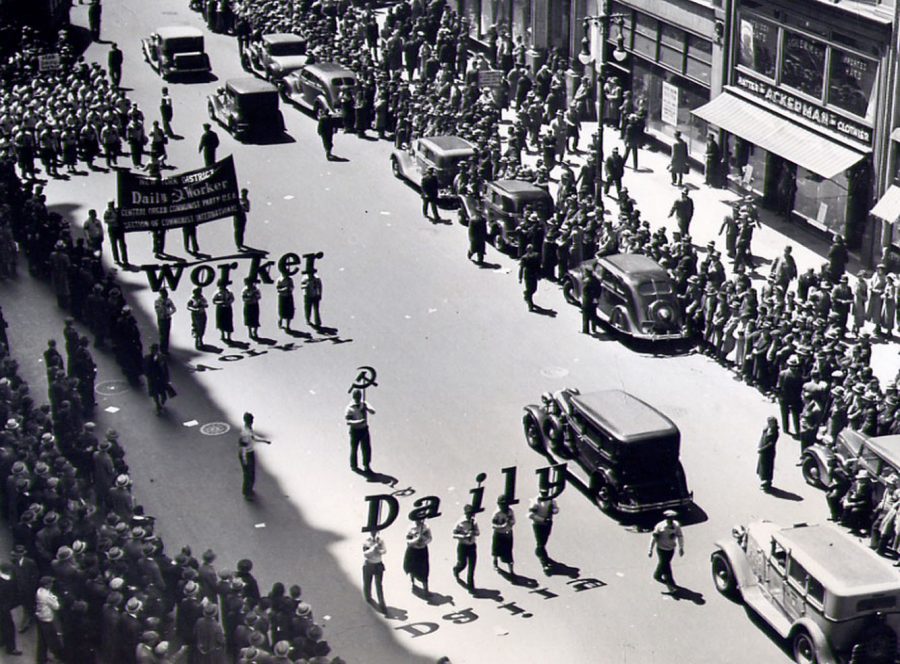
May Day riots of 1919
The Cleveland May Day riots of 1919 were a series of violent demonstrations that occurred throughout Cleveland, Ohio on May 1 (May Day), 1919. The riots occurred during the May Day parade organized by Socialist leader Charles Ruthenberg, of local trade unionists, socialists, communists, and the Industrial Workers of the World (IWW) to protest against the conviction of Eugene V. Debs and American intervention in the Russian Civil War against the Bolsheviks.
-

1919 Streetcar Strike of Los Angeles
The 1919 Streetcar Strike of Los Angeles was the most violent revolt to the open shop policies of the Pacific Electric Railway Company in Los Angeles. Labor organizers had fought for over a decade to increase wages, decrease work hours, and legalize unions for streetcar workers of the Los Angeles basin. After having been denied unionization rights and changes in work policies by the National War Labor Board, streetcar workers broke out in massive protest before being subdued by local armed police force.
-

La Canadenca strike
The Canadenca strike (Catalan: "Vaga de La Canadenca", Spanish: Huelga de La Canadiense) was a historic strike action in Barcelona, Catalonia, Spain, that began in February 1919 and evolved over forty-four days into a general strike paralyzing much of the industry of Catalonia. Among its consequences was to force the Spanish government to issue the Decreto de la jornada de ocho horas de trabajo, the first law limiting the working day to eight hours. The strike originated at the principal electricity company in Barcelona, Riegos y Fuerzas del Ebro, popularly known as La Canadenca because its major shareholder was the Canadian Bank of Commerce of Toronto.
-

May Fourth Movement
The May Fourth Movement was an anti-imperialist, cultural, and political movement which grew out of student protests in Beijing on 4 May 1919.
-

Broken Hill mining strike
The Broken Hill miners' strike of 1919–20 was fought over safety conditions in the mines and eventually resulted in the Holman ministry (1916–1920) setting up a royal commission into the mining industry at Broken Hill.
-

Battle of George Square
The Battle of George Square was a violent confrontation in Glasgow, Scotland between Glasgow City Police and striking Glasgow workers, centred around George Square. The 'battle', also known as "Bloody Friday" or "Black Friday", took place on Friday 31 January 1919, 82 days after the end of the First World War. In its aftermath the leaders of the strike were arrested and British troops, supported by six tanks, were moved to key points in Glasgow and its surrounding areas. There were no fatalities.
-

1919 Fremantle Wharf riot
The 1919 Fremantle Wharf riot, also known as the Battle of the Barricades, arose out of a strike by stevedores in Fremantle, Western Australia in 1919. The strike was called by the Waterside Workers' Federation (WWF) over the use of National Waterside Workers Union (NWWU) workers to unload the quarantined ship Dimboola, and escalated into fatal violence when WWF workers and supporters attempted to prevent NWWU members from carrying out the work.
-

Red Summer
Red Summer is the period from late winter through early autumn of 1919 during which white supremacist terrorism and racial riots took place in more than three dozen cities across the United States, as well as in one rural county in Arkansas. The term "Red Summer" was coined by civil rights activist and author James Weldon Johnson, who had been employed as a field secretary by the National Association for the Advancement of Colored People (NAACP) since 1916. In 1919, he organized peaceful protests against the racial violence which had occurred that summer.
-
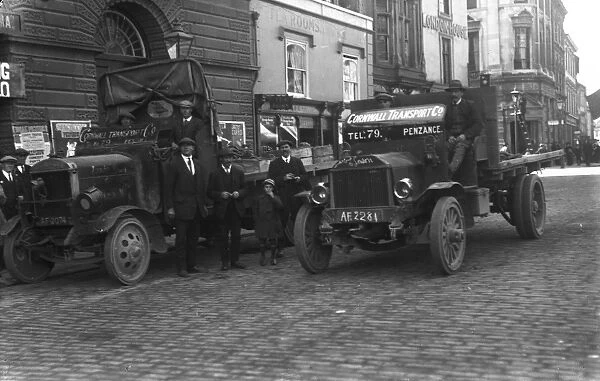
1919 United Kingdom railway strike
The 1919 United Kingdom railway strike was an industrial dispute which last nine days (midnight 26-27 September until 5 October) leading to a victory by the National Union of Railwaymen.
-

Washington race riot of 1919
The Washington race riot of 1919 was civil unrest in Washington, D.C. from July 19, 1919, to July 24, 1919. Starting July 19, white men, many in the United States Army, United States Navy, and United States Marine Corps, responded to the rumored arrest of a black man for rape of a white woman with four days of mob violence against black individuals and businesses. They rioted, randomly beat black people on the street, and pulled others off streetcars for attacks. When police refused to intervene, the black population fought back. The city closed saloons and theaters to discourage assemblies. Meanwhile, the four white-owned local papers, including the Washington Post, fanned the violence with incendiary headlines and calling in at least one instance for mobilization of a "clean-up" operation. After four days of police inaction, President Woodrow Wilson ordered 2,000 federal troops to regain control in the nation's capital. But a violent summer rainstorm had more of a dampening effect. When the violence ended, 15 people had died: at least 10 white people, including two police officers; and around 5 black people. Fifty people were seriously wounded and another 100 less severely wounded. It was one of the few times in 20th-century riots of whites against blacks that white fatalities outnumbered those of black people. The unrest was also one of the Red Summer riots in America.
-
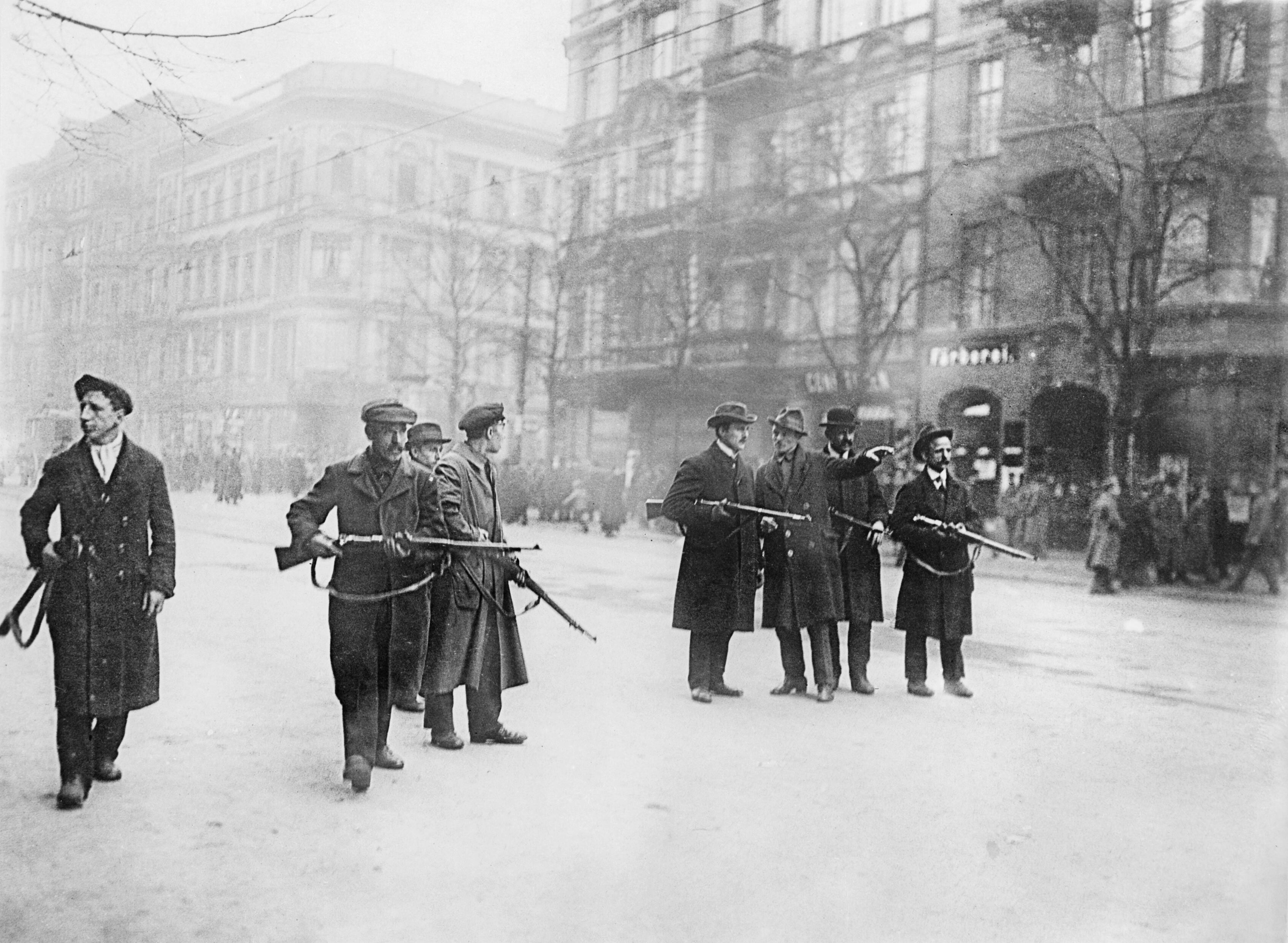
Spartacist uprising
The Spartacist uprising (German: Spartakusaufstand), also known as the January uprising (Januaraufstand), was a general strike (and the armed battles accompanying it) in Berlin from 5 to 12 January 1919. Germany was in the middle of a post-war revolution, and two of the perceived paths forward were social democracy and a socialist council republic. The uprising was primarily a power struggle between the moderate Social Democratic Party of Germany (SPD) led by Friedrich Ebert and the radical communists of the Communist Party of Germany (KPD), led by Karl Liebknecht and Rosa Luxemburg, who had previously founded and led the Spartacist League (Spartakusbund).
-

Steel strike of 1919
The steel strike of 1919 was an attempt by the weakened Amalgamated Association of Iron, Steel and Tin Workers (AA) to organize the United States steel industry in the wake of World War I. The strike began on September 22, 1919, and collapsed on January 8, 1920.
-

Baltimore riots of 1919
The Baltimore riots of 1919 were a series of riots connected to the Red Summer of 1919. As more and more African-Americans moved from the south to the industrial north they started to move into predominantly white neighborhoods. This change in the racial demographics of urban areas increased racial tension that occasionally boiled over into civil unrest.
-

Proskurov pogrom
The Proskurov pogrom took place on 15 February 1919 in the town of Proskurov during the Ukrainian War of Independence, (now, Khmelnytskyi) which was taken over from under the Bolshevik control by the Haidamacks. In mere three and a half hours at least 1,500 Jews were murdered, up to 1,700 by other estimates, and more than 1,000 wounded including women, children and the old. The massacre was carried out by Ukrainian People's Republic soldiers of Ivan Samosenko. They were ordered to save the ammunition in the process and use only lances and bayonets.
-

Sudetská demonstrace
Tzv. sudetská demonstrace, či demonstrace sudetských Němců z úterý 4. března 1919 byla demonstrace v Československu, při níž sudetští Němci požadovali začlenění svého území v rámci Německého Rakouska namísto určení trvalého pobytu v novém československém státě. Demonstrace se konaly například ve městech Teplice, Kadaň nebo Nový Jičín.
-

1919 Actors' Equity Association strike
The 1919 Actors' Equity Association strike officially spanned from August 7, 1919, to September 6, 1919. In the late 19th and early 20th centuries, the theatre industry was revolutionized by powerful management groups that monopolized and centralized the industry. These groups created harsh working conditions for the actors. On May 26, 1913, actors decided to unionize, and they formed the Actors' Equity Association (AEA or "Equity"). After many failed attempts to negotiate with the producers and managers for fair treatment and a standard contract, Equity declared a strike against the Producing Managers' Association on August 7, 1919. During the strike, the actors walked out of theaters, held parades in the streets, and performed benefit shows. Equity received support from the theatrical community, the public, and the American Federation of Labor, and on September 6, 1919, the actors won the strike. The producers signed a contract with the AEA that contained nearly all of Equity's demands. The strike was important because it expanded the definition of labor and altered perceptions about what types of careers could organize. The strike also encouraged other groups within the theatre industry to organize.
-

Boston cigar makers strike of 1919
On July 7, 1919, roughly 2,100 of Boston's 2,400 cigar makers walked off the job in protest of their employer's failure to meet their demand of a 13 7/11% raise. Three of Boston's largest cigar manufacturers chose to leave the city rather than meet the union's demands and a number of union members formed a cigar-making co-operative. By August 30, 1919, all of the remaining manufacturers had reached agreements with the union.
-

Boston Police Strike
In the Boston Police Strike, Boston police officers went on strike on September 9, 1919. They sought recognition for their trade union and improvements in wages and working conditions. Police Commissioner Edwin Upton Curtis denied that police officers had any right to form a union, much less one affiliated with a larger organization like the American Federation of Labor (AFL). Attempts at reconciliation between the Commissioner and the police officers, particularly on the part of Boston's Mayor Andrew James Peters, failed.
-

Winnipeg general strike
The Winnipeg general strike of 1919 was one of the most famous and influential strikes in Canadian history. For six weeks, May 15 to June 26, more than 30,000 strikers brought economic activity to a standstill in Winnipeg, Manitoba, which at the time was Canada's third largest city. In the short term, the strike ended in arrests, bloodshed and defeat, but in the long run it contributed to the development of a stronger labour movement and the tradition of social democratic politics in Canada.
-
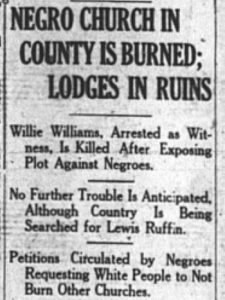
Jenkins County, Georgia, riot of 1919
The Jenkins County riot of 1919 took place on Sunday, April 13, 1919, when a series of misunderstandings and out-of-control events spiralled into two white police officers being killed. In retaliation the local white community formed mobs and ravaged the black community, burning black community buildings and killing at least four people.
-

Annapolis riot of 1919
The Annapolis riot of 1919 took place on June 27, 1919, between midnight and 1 AM, in Annapolis, Maryland. A mob of African-American bluejackets from the U.S. Navy fought local Annapolis African- Americans.
-

Cardiff race riot
no info
-

Charleston riot of 1919
The Charleston riot of 1919 was a race riot that took place on the night of Saturday, May 10, 1919, between members of the US Navy and the local black population. They attacked black individuals, businesses, and homes killing six and injuring dozens.
-

Blue flu
A blue flu is a type of strike action undertaken by police officers in which a large number simultaneously use sick leave. A blue flu is a preferred strike action by police in some parts of the United States where police strikes are prohibited by law. At times, the matter goes to court, such as when officers need to undergo medical examination to prove genuine illness. A 2019 opinion piece in The New York Times contrasted blue flu with a strike, calling it "a quiet form of protest, with no stated principles or claim for public attention or sympathy." Unlike most strikes, blue flu tends to be focused and of short duration.
-
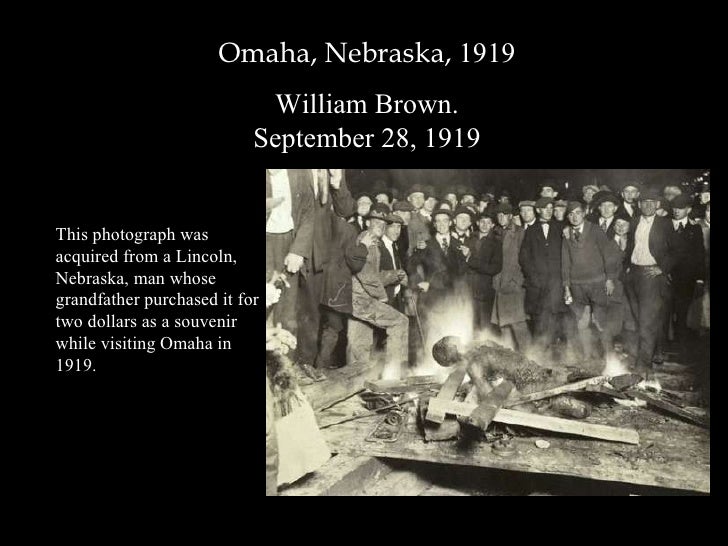
Omaha race riot of 1919
The Omaha race riot occurred in Omaha, Nebraska, September 28–29, 1919. The race riot resulted in the lynching of Will Brown, a black civilian; the death of two white rioters; the injuries of many Omaha Police Department officers and civilians, including the attempted hanging of Mayor Edward Parsons Smith; and a public rampage by thousands of white rioters who set fire to the Douglas County Courthouse in downtown Omaha. It followed more than 20 race riots that occurred in major industrial cities of the United States during the Red Summer of 1919.
-

Corbin, Kentucky race riot of 1919
Corbin, Kentucky race riot of 1919 was a race riot in 1919 in which a white mob forced nearly all the town's 200 black residents onto a freight train out of town, and a sundown town policy until the late 20th century.
-

Port Arthur riot 1919
The Port Arthur riot happened on July 15, 1919, in Port Arthur, Texas. Violence started after a group of white men objected to an African American smoking near a white woman on a street car. A "score" of whites and twice that number of African Americans battled in the streets leaving two seriously injured and dozens with minor injuries.
-

Macon, Mississippi, race riot
The Macon, Mississippi, race riot took place on June 7, 1919, in Macon, Mississippi. Members of the white community were angry that some people were organizing to fight for better work conditions and so beat, whipped and then forced them into exile.
-

Epsom riot
The Epsom riot occurred when about 400 Canadian soldiers rioted and attacked the police station at Epsom, Surrey on 17 June 1919, resulting in the death of Station-Sergeant Thomas Green, a British police officer, who died of his injuries the following day.
-
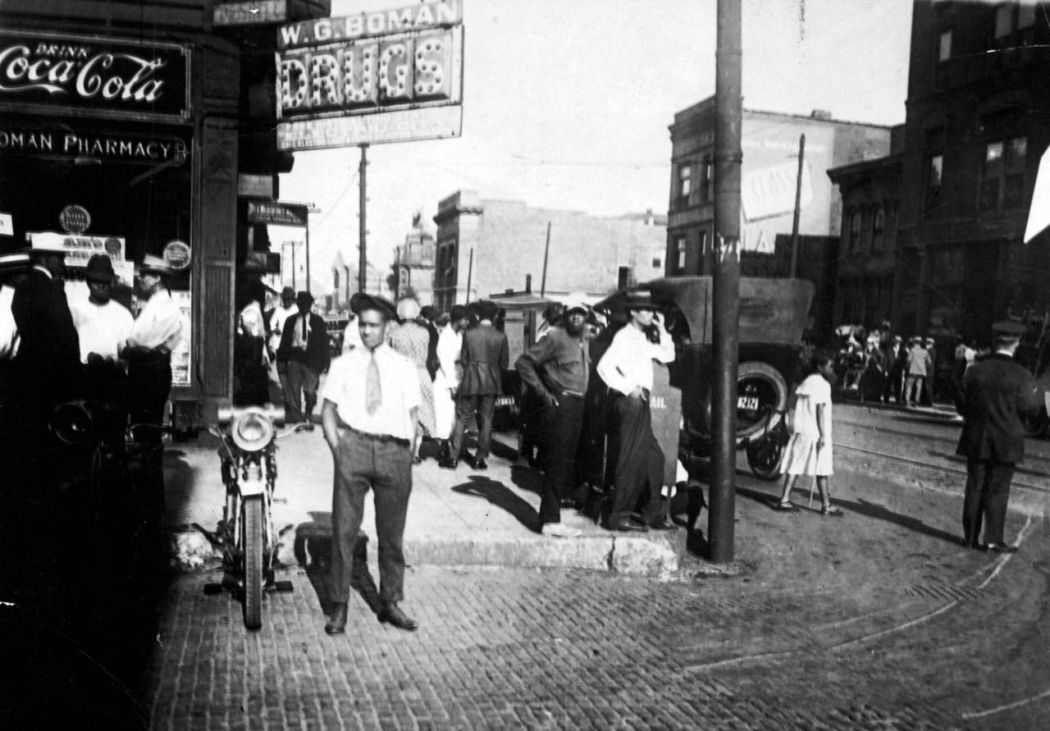
Chicago race riot of 1919
The Chicago race riot of 1919 was a violent racial conflict started by white Americans against black Americans that began on the South Side of Chicago, Illinois on July 27, and ended on August 3, 1919. During the riot, thirty-eight people died (23 black and 15 white). Over the week, injuries attributed to the episodic confrontations stood at 537, with two-thirds of the injured being black and one-third white, while the approximately 1,000 to 2,000 who lost their homes were mostly black. It is considered the worst of the nearly 25 riots and civil disturbances in the United States during the "Red Summer" of 1919, so named because of the racial and labor related violence and fatalities across the nation. The prolonged conflict made it one of the worst riots in the history of Illinois.
-
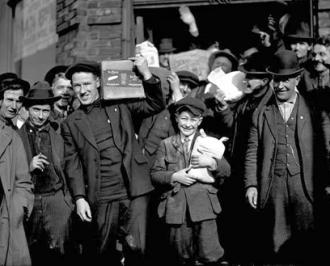
Seattle General Strike
The Seattle General Strike of 1919 was a five-day general work stoppage by more than 65,000 workers in the city of Seattle, Washington from February 6 to 11. Dissatisfied workers in several unions began the strike to gain higher wages after two years of World War I wage controls. Most other local unions joined the walk-out, including members of the American Federation of Labor (AFL) and the Industrial Workers of the World (IWW). Government officials, the press, and much of the public viewed the strike as a radical attempt to subvert American institutions.
-

Elaine massacre
The Elaine massacre occurred on September 30–October 1, 1919, at Hoop Spur in the vicinity of Elaine in rural Phillips County, Arkansas. Some records of the time state that eleven black men and five white men were killed. Estimates of deaths made in the immediate aftermath of the Elaine Massacre by eyewitnesses range from 50 to "more than a hundred". Walter White, an NAACP attorney who visited Elaine, AR shortly after the incident stated "... twenty-five Negroes killed, although some place the Negro fatalities as high as one hundred". More recent estimates of the number of black people killed during this violence are higher than estimates provided by the eyewitnesses, recently ranging into the hundreds. The white mobs were aided by federal troops (requested by Arkansas governor Charles Brough) and vigilante militias like the Ku Klux Klan. According to the Encyclopedia of Arkansas, "the Elaine Massacre was by far the deadliest racial confrontation in Arkansas history and possibly the bloodiest racial conflict in the history of the United States".
-

Battle of Bow Street
The Battle of Bow Street is the name given to a riot which took place in Bow Street, London, during March 1919. The riot involved an estimated 2,000 Australian, American and Canadian servicemen fighting against 50 Metropolitan Police officers.
-

1920 Nebi Musa riots
The 1920 Nebi Musa riots or 1920 Jerusalem riots took place in British-controlled part of Occupied Enemy Territory Administration between Sunday, 4 and Wednesday, 7 April 1920 in and around the Old City of Jerusalem. Five Jews and four Arabs were killed, and several hundred were injured. The riots coincided with and are named after the Nebi Musa festival, which took place every year on Easter Sunday, and followed rising tensions in Arab-Jewish relations. The events came shortly after the Battle of Tel Hai and the increasing pressure on Arab nationalists in Syria in the course of the Franco-Syrian War.
-
Żeligowski's Mutiny
Żeligowski's Mutiny (Polish: bunt Żeligowskiego also żeligiada, Lithuanian: Želigovskio maištas) was a Polish false flag operation led by General Lucjan Żeligowski in October 1920, which resulted in the creation of the Republic of Central Lithuania. Polish Chief of State Józef Piłsudski surreptitiously ordered Żeligowski to carry out the operation, and revealed the truth several years later. The area was formally annexed by Poland in 1922 and internationally recognized as Polish territory in 1923. Nevertheless, Lithuania continued to claim the Vilnius region.
-

Prosincová generální stávka 1920
Prosincová generální stávka 1920 byla výsledkem sporu dvou frakcí v Československé sociálně demokratické straně dělnické o majetek.
-

Nakba Day
Nakba Day (Arabic: يوم النكبة, romanized: Yawm an-Nakba, lit. 'Day of the Catastrophe') is generally commemorated on 15 May, the day after the Gregorian calendar date for Israeli Independence Day (Yom Ha'atzmaut). For the Palestinians it is an annual day of commemoration of the displacement that preceded and followed the Israeli Declaration of Independence in 1948.
-

Hurtsboro race riot
The Hurtsboro race riot was conflict between Black and White residents of Hurtsboro, Alabama in the final days of 1920.
-
Milli Aşireti Ayaklanması Vikipedi
Milli Aşireti Ayaklanması (1 Haziran-8 Eylül 1920), Urfa’da yaşayan Milli aşiretinin Fransızlarla iş birliği yaparak çıkardığı ayaklanmadır. Millî kuvvetlerce bastırılmıştır.
-

Husino rebellion
Husino rebellion (Serbo-Croatian: Husinska buna, Хусинска буна)[a] was a short-lived miners strike and armed rebellion against industrial slavery in the newly established Kingdom of Serbs, Croats and Slovenes. 7,000 miners from Tuzla, Breza and Zenica in central Bosnia, participated in the strike in the village of Husino in Tuzla. When the local government tried to force the miners back to work, they resisted with firearms and the uprising was put down with great violence. Seven workers were killed and four-hundred arrested. The uprising was put down, but its memory was preserved as part of Tuzla’s anti-authoritarian legacy.
-
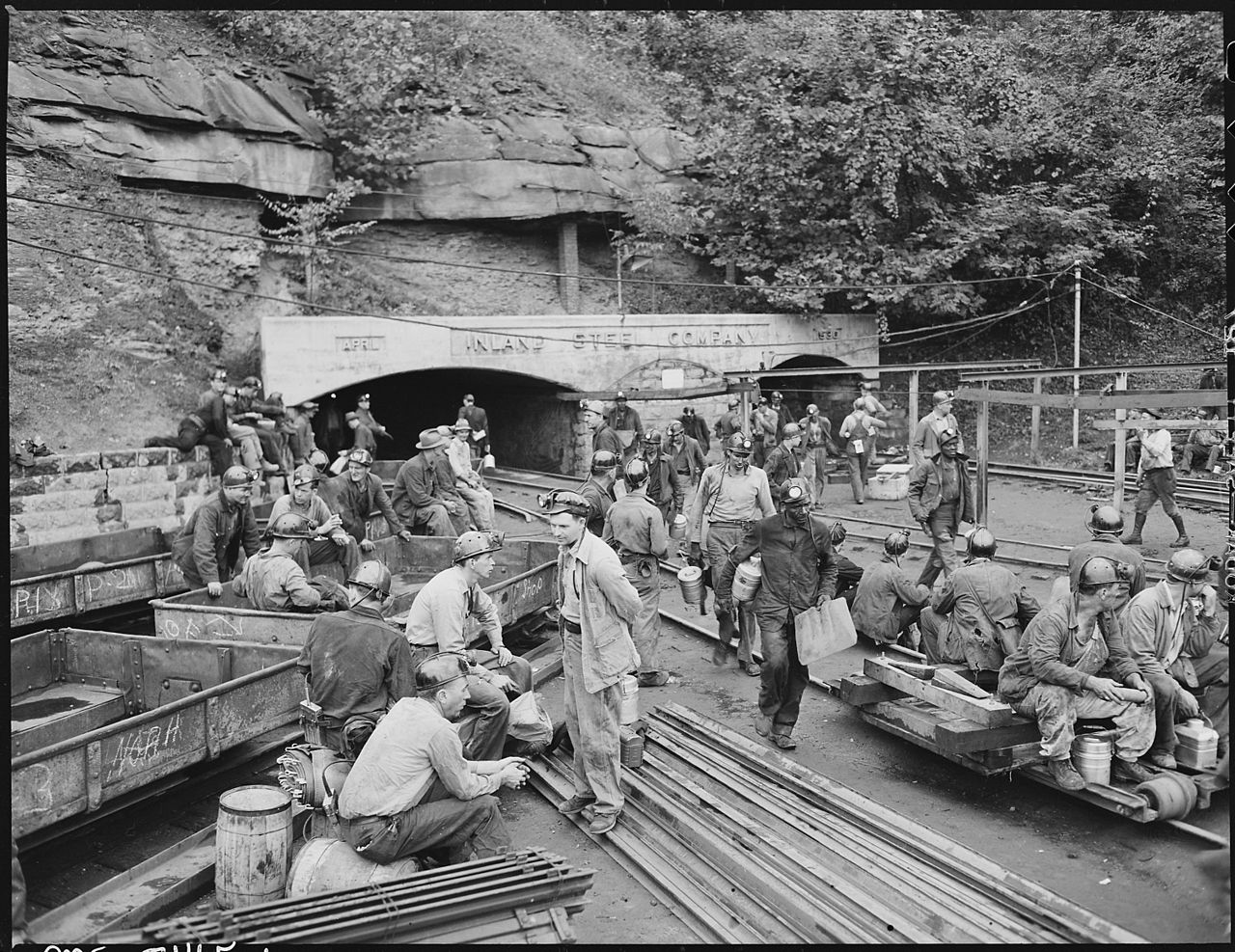
1920 Alabama coal strike
The 1920 Alabama coal strike, or the Alabama miners' strike, was a statewide strike of the United Mine Workers of America against coal mine operators. The strike was marked by racial violence, and ended in significant defeat for the union.
-

Listowel mutiny
The Listowel mutiny occurred during the Irish War of Independence when Royal Irish Constabulary officers under the command of County Inspector O'Shea refused to be relocated out of their rural police station in Listowel, County Kerry and moved to other areas.
-

Broome race riots of 1920
A series of riots involving some members of the Japanese and Indonesian (mainly from Kupang in Timor) communities took place in Broome, a town in northern Western Australia in December 1920.
-

1920 Romanian general strike
The 1920 Romanian general strike was a major nationwide strike in the Kingdom of Romania, lasting between October 20 and 28 and involved the participation of most of the over 400,000 industrial workers from across the country. The demands of the workers included the recognition of the workers' factory committees, demilitarization of the industrial enterprises, abolition of the state of siege, elimination of censorship and the adoption of a new legislation regarding labour disputes. The strike was violently repressed by the government using the Romanian Army and the leaders of the workers were sentenced to prison.[citation needed]
-

Denver streetcar strike of 1920
The Denver streetcar strike of 1920 was a labor action and series of urban riots in downtown Denver, Colorado, beginning on August 1, 1920, and lasting six days. Seven were killed and 50 were seriously injured in clashes among striking streetcar workers, strike-breakers, local police, federal troops and the public. This was the "largest and most violent labor dispute involving transportation workers and federal troops".
-

Oahu sugar strike of 1920
The Oahu sugar strike of 1920 was a multiracial strike in Hawaii of two unions, the Filipino American Filipino Labor Union and the Japanese American Federation of Japanese Labor. The labor action involved 8,300 sugar plantation field workers out on strike from January to July 1920.
-

Strajk kolejarzy w Poznaniu (1920)
Strajk kolejarzy w Poznaniu – krwawo stłumiony przez policję strajk robotników poznańskich warsztatów przemysłu kolejowego 26 kwietnia 1920 r. W wyniku ran postrzałowych zmarło 9 robotników, a 30 odniosło rany.


